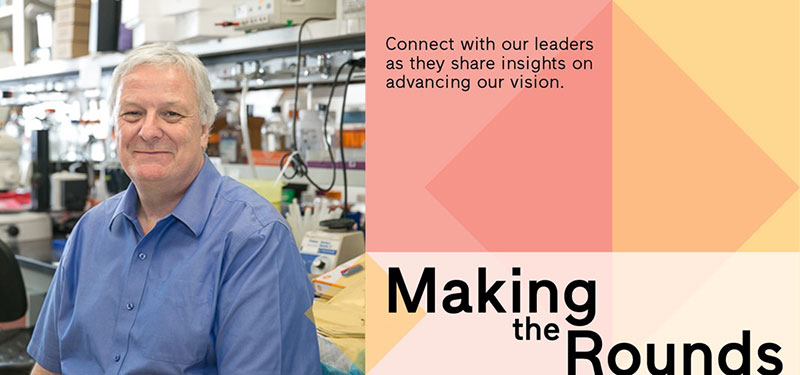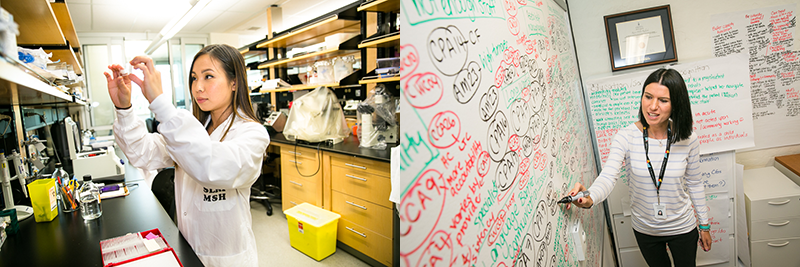
by Dr. Jim Woodgett, Director, Lunenfeld-Tanenbaum Research Institute
We are, all of us at Sinai Health, ostensibly, advocates. Every day, clinicians advocate for our patients; families and carers advocate for loved ones being cared for; our leaders and partners advocate for better access to care for the most vulnerable and marginalized in our communities. And here at the Lunenfeld-Tanenbaum Research Institute and Bridgepoint’s Collaboratory, we advocate for the resources needed to continue the vital work of our scientists. This can be difficult because the fruits of research are new knowledge and, we hope, future positive impact on quality of life and health. Yet we also know from past experience that future progress and prosperity derives from scientific investment.  We shifted our research advocacy efforts into a higher gear this past year in response to a government commissioned review of fundamental science, chaired by Professor David Naylor, past President of the University of Toronto. The report, published last April, was the first in over 40 years on this topic. The review showed a steady decline in investments and made 35 recommendations to restore Canada’s strength in discovery science. Given the typical cacophony associated with getting a bunch of scientists together – we will argue the colour of the sky till the cows come home – the research community rallied around the Naylor report and spoke with one voice. Indeed, the importance of this advocacy work for us, as an academic research centre, cannot be overstated.
We shifted our research advocacy efforts into a higher gear this past year in response to a government commissioned review of fundamental science, chaired by Professor David Naylor, past President of the University of Toronto. The report, published last April, was the first in over 40 years on this topic. The review showed a steady decline in investments and made 35 recommendations to restore Canada’s strength in discovery science. Given the typical cacophony associated with getting a bunch of scientists together – we will argue the colour of the sky till the cows come home – the research community rallied around the Naylor report and spoke with one voice. Indeed, the importance of this advocacy work for us, as an academic research centre, cannot be overstated.
Two weeks ago the Federal government released budget 2018 and it contained a solid dose of good medicine for Canadian health researchers. The federal government is the largest funder of biomedical research in Canada through various agencies including the Canadian Institutes for Health Research (CIHR) and Sinai Health System researchers (LTRI/ Bridgepoint Collaboratory) annually attract $35 million in competitive federal research funds from Ottawa.
CIHR and its fellow agencies were given a funding boost and a commitment over the next five years. This will undoubtedly provide sustainability and promote research across Canada. Overall, the budget committed about a 17 per cent increase, spread over five years. That may not sound like too much, but if the investment is shown to work well, there should be opportunities to justify additional investments.
Sinai Health System also holds 12 Federal Chairs which support our ability to attract and retain some of the best researchers in North America so I was pleased to see additional funding for the Canada Research Chairs program. There was also stability provided to the Canada Foundation for Innovation which helps support research infrastructure such as laboratory equipment and leading-edge facilities such as the Centre for Phenogenomics, based at LTRI.
 As many of you may know, I feel very strongly about the need to communicate broadly about the impact that science has in all of our lives. We too often take this for granted and need to help people outside of our own walls appreciate the sense of awe, the optimism of discovery and the potential of impact on treating challenging diseases that emerge from basic science. As exciting as it is to see a fellow researcher nail down new understanding of an important cellular process, it is similarly gratifying to share the moment a non-scientist has their breath taken away by a startling new scientific revelation. Like art, science is often messy in the making with its value becoming clear only after reflection. It was hence reassuring to see that the themes of Dr. Naylor’s report recognizing the importance of not restricting ideas or requiring immediate returns on investment, of increasing funding agency coordination to promote interdisciplinary, of greater stability of funding, promotion of equity and diversity as well as support of young researchers. Each of these elements found a place in the details of the budget. That’s surely a reflection of the consistent and clear message from the Canadian research community in supporting the report. Indeed, one of the most important developments of the past year was the degree to which our young, diverse and inspirational trainees became personally involved. They saw their futures and aspirations were on the line. Once government saw their ideas aligned well with those of future young researchers the initiative was given the break it had been striving for. Our trainees even taught us older folks how to better engage in social media campaigns, removing the occasional virus from our devices at the same time. And, of course, we’re now starting to prepare for Budget 2019.
As many of you may know, I feel very strongly about the need to communicate broadly about the impact that science has in all of our lives. We too often take this for granted and need to help people outside of our own walls appreciate the sense of awe, the optimism of discovery and the potential of impact on treating challenging diseases that emerge from basic science. As exciting as it is to see a fellow researcher nail down new understanding of an important cellular process, it is similarly gratifying to share the moment a non-scientist has their breath taken away by a startling new scientific revelation. Like art, science is often messy in the making with its value becoming clear only after reflection. It was hence reassuring to see that the themes of Dr. Naylor’s report recognizing the importance of not restricting ideas or requiring immediate returns on investment, of increasing funding agency coordination to promote interdisciplinary, of greater stability of funding, promotion of equity and diversity as well as support of young researchers. Each of these elements found a place in the details of the budget. That’s surely a reflection of the consistent and clear message from the Canadian research community in supporting the report. Indeed, one of the most important developments of the past year was the degree to which our young, diverse and inspirational trainees became personally involved. They saw their futures and aspirations were on the line. Once government saw their ideas aligned well with those of future young researchers the initiative was given the break it had been striving for. Our trainees even taught us older folks how to better engage in social media campaigns, removing the occasional virus from our devices at the same time. And, of course, we’re now starting to prepare for Budget 2019.

